 Sustainability has become one of the most pressing issues facing society. Patterns of human production and consumption have become unsustainable. On the environmental front, climate change, land-use change, biodiversity loss and depletion of natural resource are destabilising the Earth’s eco-system.
Sustainability has become one of the most pressing issues facing society. Patterns of human production and consumption have become unsustainable. On the environmental front, climate change, land-use change, biodiversity loss and depletion of natural resource are destabilising the Earth’s eco-system.
Furthermore, data on poverty, hunger and lack of healthcare show that many people live below minimum social standards. This has led to greater emphasis being placed on sustainable development: ‘development that meets the needs of the present without compromising the ability of future generations to meet their own needs’ (The Brundtland Report, 1987: Ch.2, para. 1).
The financial system has an important role to play in channelling capital in a more sustainable way. Since current models of finance do not consider the welfare of future generations in investment decisions, sustainable finance has been developed to analyse how investment and lending decisions can manage the trade-off inherent in sustainable development: sacrificing return today to enhance the welfare of future generations.
However, some commentators argue that such trade-offs are not required. They suggest that investors can ‘do well by doing good’. In this blog, I will use ‘green’ bonds (debt instruments which finance projects or activities with positive environmental and social impacts) to explain the economics underpinning sustainable finance and show that doing good has a price that sustainable investors need to be prepared to pay.
I will analyse why investors might not be doing so and point to changes which may be required to ensure financial markets channel capital in a way consistent with sustainable development.
The growth of sustainable finance
 Sustainable finance has grown rapidly over the past decade as concerns about climate change have intensified. A significant element of this growth has been in global debt markets.
Sustainable finance has grown rapidly over the past decade as concerns about climate change have intensified. A significant element of this growth has been in global debt markets.
Figure 1 illustrates the rapid growth in the issuance of sustainability-linked debt instruments since 2012. While issuance fell in 2022 due to concerns about rising inflation and interest rates reducing the real return of fixed-income debt securities, it rebounded in 2023 and is on course for record levels in 2024. (Click here for a PowerPoint.)
Green bonds are an asset class within sustainability-linked debt. Such bonds focus on financing projects or activities with positive environmental and social impacts. They are typically classified as ‘use-of-proceeds’ or asset-linked bonds, meaning that the proceeds raised from their issuance are earmarked for green projects, such as renewable energy, clean transportation, and sustainable agriculture. Such bonds should be attractive to investors who want a financial return but also want to finance investments with a positive environmental and/or social impact.
One common complaint from commentators and investors is the ‘greenium’ – the price premium investors pay for green bonds over conventional ones. This premium reduces the borrowing costs of the issuers (the ‘counterparties’) compared to those of conventional counterparties. This produces a yield advantage for issuers of green bonds (price and yield have a negative relationship), reducing their borrowing costs compared to issuers of conventional bonds.
An analysis by Amundi in 2023 using data from Bloomberg estimated that the average difference in yield in developed markets was –2.2 basis points (–0.022 percentage points) and the average in emerging markets was –5.6 basis points (–0.056 percentage points). Commentators and investors suggest that the premium is a scarcity issue and once there are sufficient green bonds, the premium over non-sustainable bonds should disappear.
However, from an economics perspective, such interpretations of the greenium ignore some fundamentals of economic valuation and the incentives and penalties through which financial markets will help facilitate more sustainable development. Without the price premium, investors could buy sustainable debt at the same price as unsustainable debt, earn the same financial return (yield) but also achieve environmental and social benefits for future generations too. Re-read that sentence and if it sounds too good to be true, it’s because it is too good to be true.
‘There is no such thing as a free lunch’
In theory, markets are institutional arrangements where demand and supply decisions produce price signals which show where resources are used most productively. Financial markets involve the allocation of financial capital. Traditional economic models of finance ignore sustainability when appraising investment decisions around the allocation of capital. Consequently, such allocations do not tend to be consistent with sustainable development.
In contrast, economic models of sustainable finance do incorporate such impacts of investment decisions and they will be reflected in the valuation, and hence pricing, of financial instruments. Investors, responding to the pricing signals will reallocate capital in a more sustainable manner.
 Let’s trace the process. In models of sustainable finance, financial instruments such as green bonds funding investments with positive environmental impacts (such as renewable energy) should be valued more, while instruments funding investments with negative environmental impacts (such as fossil fuels) should be valued less. The prices of the green bonds financing renewable energy projects should rise while the prices of conventional bonds financing fossil-fuel companies should fall.
Let’s trace the process. In models of sustainable finance, financial instruments such as green bonds funding investments with positive environmental impacts (such as renewable energy) should be valued more, while instruments funding investments with negative environmental impacts (such as fossil fuels) should be valued less. The prices of the green bonds financing renewable energy projects should rise while the prices of conventional bonds financing fossil-fuel companies should fall.
As this happens, the yield on the green bonds falls, lowering the cost of capital for renewable-energy projects, while yields on the bonds financing fossil-fuel projects rise, ceteris paribus. As with any market, these differential prices act as signals as to where resources should be allocated. In this case, the signals should result in an allocation consistent with sustainable development.
The fundamental point in this economic valuation is that sustainable investors should accept a trade-off. They should pay a premium and receive a lower rate of financial return (yield) for green bonds compared to conventional ones. The difference in price (the greenium), and hence yield, represents the return investors are prepared to sacrifice to improve future generations’ welfare. Investors cannot expect to have the additional welfare benefit for future generations reflected in the return they receive today. That would be double counting. The benefit will accrue to future generations.
A neat way to trace the sacrifice sustainable investors are prepared to make in order to enhance the welfare of future generations is to plot the differences in yields between green bonds and their comparable conventional counterparts. The German government has issued a series of ‘twin’ bonds in recent years. These twins are identical in every respect (coupon, face value, credit risk) except that the proceeds from one will be used for ‘green’ projects only.
 Figure 2 shows the difference in yields on a ‘green bond’ and its conventional counterpart, both maturing on 15/8/2050, between June 2021 and July 2024. The yield on the green bond is lower – on average about 2.2 basis points (0.022 percentage points) over the period. This represents the sacrifice in financial return that investors are prepared to trade off for higher environmental and social welfare in the future. (Click here for a PowerPoint.)
Figure 2 shows the difference in yields on a ‘green bond’ and its conventional counterpart, both maturing on 15/8/2050, between June 2021 and July 2024. The yield on the green bond is lower – on average about 2.2 basis points (0.022 percentage points) over the period. This represents the sacrifice in financial return that investors are prepared to trade off for higher environmental and social welfare in the future. (Click here for a PowerPoint.)
The yield spread fluctuates through time, reflecting changing perceptions of environmental concerns and hence the changing value that sustainable investors attach to future generations. The spread tends to widen when there are heightened environmental concerns and to narrow when such concerns are not in the news. For example, the spread on the twin German bonds reached a maximum of 0.045 percentage points in November 2021. This coincided with the 26th UN Climate Change Conference of the Parties (COP26) in Glasgow. The spread has narrowed significantly since early 2022 as rising interest rates and falling real rates of return on bonds in the near-term seem to have dominated investors’ concerns.
These data suggest that, rather than being too large, the greeniums are too small. The spreads suggest that markets in debt instruments do not seem to attach much value to future generations. The valuation, price and yield of green bonds are not significantly different from their conventional counterparts. This narrow gap indicates insufficient reward for better sustainability impact and little penalty for worse sustainability impact.
This pattern is repeated across financial markets and does not seem to be stimulating the necessary investment to achieve sustainable development. An estimate of the scale of the deficit in green financing is provided by Bloomberg NEF (2024). While global spending on the green energy transition reached $1.8 trillion in 2023, Bloomberg estimates that $4.8 trillion needs to be invested every year for the remainder of this decade if the world is to remain on track under the ‘net zero’ scenario. Investors do not seem to be prepared to accept the trade-off needed to provide the necessary funds.
Can financial markets deliver sustainable development?
Ultimately, the hope is that all financial instruments will be sustainable. In order to achieve that, access to finance would require all investors to incorporate the welfare of future generations in their investment decisions and accept sacrificing sufficient short-term financial return to ensure long-term sustainable development. Unfortunately, the pricing of green bonds suggests that investors are not prepared to accept the trade-off. This restricts the ability of financial markets to deliver an allocation of resources consistent with sustainable development.
There are several reasons why financial markets may not be valuing the welfare of future generations fully.
- Bounded rationality means that it is difficult for sustainable investors to assign precise values to future and distant benefits.
- There are no standardised sustainability metrics available. This produces great uncertainty in the valuation of future welfare.
- Investors also exhibit cognitive biases, which means they may not value the welfare of future generations properly. These include present bias (favouring immediate rewards) and hyperbolic discounting (valuing the near future more than the distant future).
- Economic models of financial valuation use discount rates to assess the value of future benefits. Higher discount rates reduce the perceived value of benefits occurring in the distant future. As a result, long-term impacts (such as environmental conservation) may be undervalued.
- There may be large numbers of investors who are only interested in financial returns and so do not consider the welfare of future generations in their investment decisions.
Consequently, investors need to be educated about the extent of trade-offs required to achieve the necessary investments in sustainable development. Furthermore, practical models which better reflect the welfare of future generations in investment decisions need to be employed. However, challenges persist in fully accounting for future generations and it may need regulatory frameworks to provide appropriate incentives for effective sustainable investment.
Articles
- The fallacy of ESG investing
Financial Times, Robert Armstrong (23/10/20)
- Energy Transition Investment Trends 2024: Executive Summary
BloombergNEF (30/1/24)
- ESG metrics trip up factor investors
Financial Times, Emma Boyde (1/11/21)
- Our Common Future: Report of the World Commission on Environment and Development
United Nations, Gro Harlem Brundtland (chair) (20/3/87)
 Who killed the ESG party?
Who killed the ESG party?FT Film, Daniel Garrahan (17/7/24)
- Green bond issuance surges as investors hunt for yield
Financial Times, Lee Harris (19/6/24)
- Investing for long-term value creation
Journal of Sustainable Finance & Investment, 9(4), Dirk Schoenmaker and Willem Schramade (19/6/19)
- Facts and Fantasies about the Green Bond Premium
Amundi working paper 102-2020, Mohamed Ben Slimane, Dany Da Fonseca and Vivek Mahtani (December 2020)
- Climate change and growth
Industrial and Corporate Change, 32 (2), 2023, Nicholas Stern and Joseph E Stiglitz (30/7/24)
Report
Data
Questions
- Using demand and supply analysis, illustrate and explain the impact of sustainable investing on the markets for (i) green bonds and (ii) conventional bonds. Highlight how this should produce an allocation of finance capital consistent with sustainable development.
- Research the yields on the twin bonds issued by Germany since this blog was published. Can you identify any association between heightened environmental concerns and the spread between the ‘green’ and conventional bond?
- Analyse the issues which prevent financial markets from producing the pricing signals which produce an allocation of resources consistent with sustainable development.
- Research some potential regulatory policies which may provide appropriate incentives for sustainable investment.

Climate change is not just an environmental challenge: its socioeconomic impacts are profound and far-reaching, touching every aspect of society. From agriculture to health, from urban infrastructure to coastal communities, the effects of climate change are evident and escalating.
The far-reaching effects
In agriculture, rising temperatures, more intense and frequent heatwaves and changing precipitation patterns pose significant threats to food security.1, 2 Crop yields decline as extreme weather events become more frequent and unpredictable, leading to increased food prices and economic instability. Smallholder farmers, who often lack the resources to adapt, are particularly vulnerable, exacerbating rural poverty and food insecurity.3
 Coastal communities face the dual threats of sea-level rise and more intense storms.4 Erosion and inundation damage homes, infrastructure and livelihoods, displacing populations and disrupting local economies. The loss of coastal ecosystems further compounds these challenges, reducing natural defences against storm surges and exacerbating the impacts of climate-related disasters.
Coastal communities face the dual threats of sea-level rise and more intense storms.4 Erosion and inundation damage homes, infrastructure and livelihoods, displacing populations and disrupting local economies. The loss of coastal ecosystems further compounds these challenges, reducing natural defences against storm surges and exacerbating the impacts of climate-related disasters.
Health systems strain under the burden of climate-change-induced heatwaves, air pollution and the spread of vector-borne diseases.5, 6 Heat-related illnesses increase as temperatures rise, particularly affecting vulnerable populations such as the elderly and outdoor workers. Air pollution exacerbates respiratory conditions, leading to higher healthcare costs and decreased productivity. Vector-borne diseases, such as malaria and dengue fever, expand into new regions, placing additional strain on already overburdened health systems.
 Displacement due to climate-related disasters amplifies social inequalities and challenges urban planning and infrastructure.7 Vulnerable communities, often located in low-lying areas or informal settlements, bear the brunt of climate impacts, facing the loss of homes, livelihoods and community cohesion. Inadequate housing and infrastructure increase the risks associated with extreme weather events, perpetuating cycles of poverty and vulnerability.
Displacement due to climate-related disasters amplifies social inequalities and challenges urban planning and infrastructure.7 Vulnerable communities, often located in low-lying areas or informal settlements, bear the brunt of climate impacts, facing the loss of homes, livelihoods and community cohesion. Inadequate housing and infrastructure increase the risks associated with extreme weather events, perpetuating cycles of poverty and vulnerability.
Furthermore, climate change exacerbates existing socioeconomic disparities, disproportionately affecting marginalised and vulnerable populations. Indigenous communities, women, children and people living in poverty are often the hardest hit, lacking access to resources, information, and adaptive capacity.8
Policy responses
Addressing the socioeconomic impacts of climate change requires co-ordinated action across sectors and scales. Policy interventions, such as investment in climate-resilient infrastructure and the promotion of sustainable agriculture practices, are essential for building resilience and reducing vulnerability. Community-led initiatives that prioritise local knowledge and empower marginalised groups are also critical for fostering adaptive capacity and promoting social equity.
To address these challenges, projects like CROSSEU, the new €5 million Horizon Europe project (that I have the pleasure to be part of), play a crucial role in enhancing our understanding of these impacts and developing actionable strategies for resilience and adaptation. One of the key contributions of CROSSEU lies in its development of a Decision Support System (DSS) that integrates tools, measures, and policy options to address these risks in a cross-sectoral and cross-regional perspective. This DSS will support (and hopefully improve) decision-making processes at various levels, from local to EU-wide, and facilitate the adoption of evidence-based policies and measures to enhance resilience and mitigate the impacts of climate change.
Would you like to know more about CROSSEU? Follow our journey and be informed of our publications and events in our new webpage: https://crosseu.eu/9
Articles/References
- Global food security under climate change
Proceedings of the National Academy of Sciences, Josef Schmidhuber and Francesco N Tubiello (11/12/2007)
- Reducing risks to food security from climate change
Global Food Security, Bruce M Campbell et al. (2016: 11, pp 34–43)
- The value-add of tailored seasonal forecast information for industry decision making
Climate, Clare Mary Goodess et al (16/10/2022)
- Assessing climate change impacts, sea level rise and storm surge risk in port cities: a case study on Copenhagen
Climatic change, Stéphane Hallegatte, Nicola Ranger, Olivier Mestre, Patrice Dumas, Jan Corfee-Morlot, Celine Herweijer and Robert Muir Wood (7/12/2010)
- Health risks of climate change: An assessment of uncertainties and its implications for adaptation policies
Environmental Health, J Arjan Wardekker, Arie de Jong, Leendert van Bree, Wim C Turkenburg and Jeroen P van der Sluijs (19/9/2012)
- Climate Change and Temperature-related Mortality: Implications for Health-related Climate Policy
Biomedical and Environmental Sciences, Tong Shi Lu, Jorn Olsen and Patrick L Kinney (2021: 34(5) pp 379–86 )
- Climate Change, Inequality, and Human Migration
IZA Discussion Paper No. 12623, Michał Burzyński, Christoph Deuster, Frédéric Docquier and Jaime de Melo (23/9/2019)
- The trap of climate change-induced “natural” disasters and inequality
Global Environmental Change, Federica Cappelli, Valeria Costantini and Davide Consoli (30/7/2021)
- Cross-sectoral Framework for Socio-Economic Resilience to Climate Change and Extreme Events in Europe
UEA Research Project, Nicholas Vasilakos, Katie Jenkins and Rachel Warren
Questions
- How do the socioeconomic impacts of climate change differ between rural and urban communities? What factors contribute to these disparities, and how can policies address them effectively?
- In what ways do vulnerable populations, such as indigenous communities and those living in poverty, bear the brunt of climate change impacts? How can we ensure that climate adaptation strategies prioritise their needs and promote social equity?
- The blog mentions the importance of community-led initiatives in building resilience to climate change. What examples of successful community-based adaptation projects can you identify, and what lessons can be learned from their implementation?
- How can governments and organisations collaborate to address the socioeconomic impacts of climate change while also promoting economic growth and development? What role do cross-sectoral partnerships play in building resilience and fostering sustainable practices?
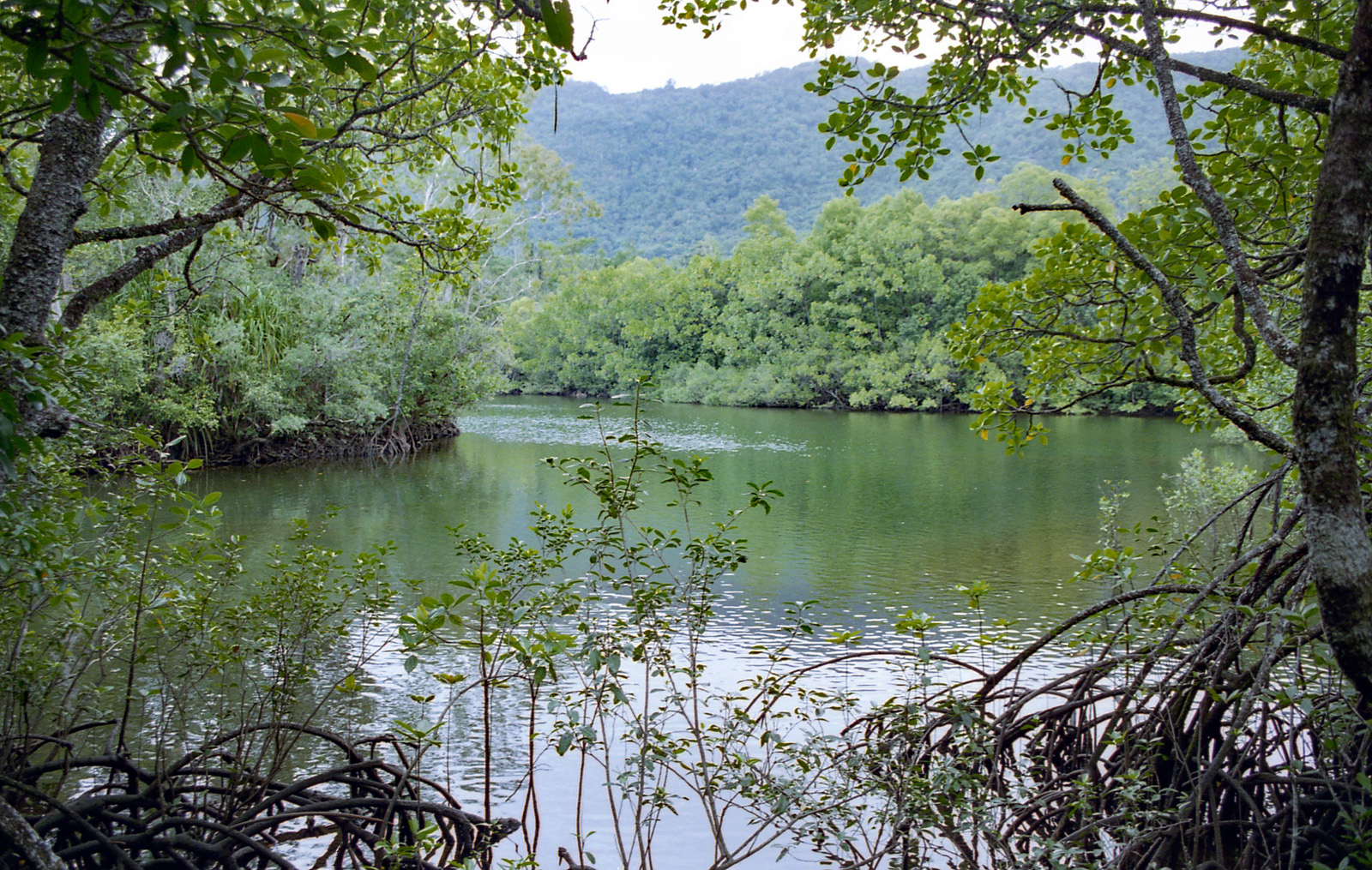 A happy New Year for 2024. Let’s hope that the coming year brings some good news amidst all the the gloom of war, squeezed living standards, the effects of climate change and the rise of authoritarian regimes.
A happy New Year for 2024. Let’s hope that the coming year brings some good news amidst all the the gloom of war, squeezed living standards, the effects of climate change and the rise of authoritarian regimes.
One piece of good news is the growth in environmental debt swaps in developing countries. These are known as debt-for-nature swaps (or debt-for-environment swaps or green debt swaps). As Case Study 26.16 in Economics (11th edition) and Case Study 15.19 in Essentials of Economics (9th edition) explain:
A debt-for-nature swap is where debts are cancelled in return for investment in environmental projects, including protecting biodiversity, reducing carbon emissions and mitigating the effect of climate change. There are two types of scheme: bilateral and commercial.
In a bilateral swap, a creditor country agrees to cancel debt in return for the debtor country investing a proportion of the amount in environmental projects. In a commercial swap, the debt owed to banks is sold to an international environmental agency at a substantial discount (or sometimes even given away); the agency then agrees to cancel this debt in return for the country funding the agency to carry out various environmental projects.
The first debt-for-nature swap was made as far back as 1987, when environmental NGO, Conservation International, arranged for Bolivia to be forgiven $650 000 of its debt in exchange for the establishment of three conservation areas bordering the Beni Reserve (see either of the above case studies). In the 1990s and 2000s, debt-for nature swaps became popular with creditors and by 2010, the total debt cancelled through debt-for-nature swaps was just over $1 billion.
However, the popularity waned in the 2010s and with COVID, many developing countries were diverting resources from long-term sustainability and mitigating the effects of climate change to emergency healthcare and relief.
 More recently, debt-for-for nature swaps have become popular again.
More recently, debt-for-for nature swaps have become popular again.
In May 2023, Ecuador benefited from the biggest debt swap to that point. The agreement saw $1.6bn of its commercial debt refinanced at a discount in exchange for large-scale conservation in and around the Galápagos Islands. At least $12m per year of the money saved will be channelled into conservation in the archipelago, with its unique flora and fauna.
Such projects are set to increase, with potentially significant beneficial effects for biodiversity, climate and the environment generally. At the COP28 summit in December 2023, a task force was set up by a group of multilateral development banks to promote an increase in the size and number of debt-for-nature swaps.
According to the Organisation for Economic Co-operation and Development (OECD), developing economies will need an annual $2.4 trillion of investment in climate action in the coming years. So far, the market for debt-for-nature swaps is set to rise to around $800bn. If they are to make a significant contribution to tackling climate change and loss of biodiversity, they need to be scaled up massively, especially as the cost of servicing debt has risen with higher global interest rates.
Nevertheless, as part of a portfolio of measures to tackle debt, climate change, loss of biodiversity and damage to the environment more generally, they are making an important contribution – a contribution that is set to rise.
Video and Webinar
Articles
Questions
- Identify other types of debt swap and discuss their importance.
- Why are debt-for-nature debt swaps in the interests of debtor countries, creditors and the world generally?
- What is ‘green washing’? How may debt-for-nature swaps be assessed to prevent such green washing?
- Why are many developing countries’ debt burdens skyrocketing?
- Why may a developing country’s solution to its growing debt be detrimental to the environment?
- Assess the Belize debt-swap deal in tackling both its debt and conservation.

Politicians, business leaders, climate scientists, interest groups and journalists from across the world have been meeting in Dubai at the COP28 climate summit (the 28th annual meeting of the Conference of the Parties (COP) to the United Nations Framework Convention on Climate Change (UNFCCC)). The meeting comes at a time when various climate tipping points are being reached or approached – some bad, but some good. Understanding these tipping points and their implications for society and policy requires understanding not only the science, but also the various economic incentives affecting individuals, businesses, politicians and societies.
Tipping points
A recent report (see first reference in articles section below) identified various climate tipping points. These are when global temperatures rise to a point where various domino effects occur. These are adverse changes to the environment that gather pace and have major effects on ecosystems and the ability to grow food and support populations. These, in turn, will have large effects on economies, migration and political stability.
 According to the report, five tipping points are imminent with the current degree of global warming (1.2oC). These are:
According to the report, five tipping points are imminent with the current degree of global warming (1.2oC). These are:
- Melting of the Greenland ice sheet;
- Melting of the West Antarctic ice sheet;
- Death of warm-water coral reefs;
- Collapse of the North Atlantic Subpolar Gyre circulation, which helps to drive the warm current that benefits Western Europe;
- Widespread rapid thawing of permafrost, where tundra without snow cover rapidly absorbs heat and releases methane (a much more powerful source of global warming than CO2).
With global warming of 1.5oC, three more tipping points are likely: the destruction of seagrass meadows, mangrove swamps and the southern part of the boreal forests that cover much of northern Eurasia. As the temperature warms further, other tipping points can interact in ways that drive one another, resulting in tipping ‘cascades’.
But the report also strikes an optimistic note, arguing that positive tipping points are also possible, which will help to slow global warming in the near future and possibly reverse it further in the future.

The most obvious one is in renewable energy. Renewable power generation in many countries is now cheaper than generation from fossil fuels. Indeed, in 2022, over 80% of new electricity generation was from solar and wind. And as it becomes cheaper, so this will drive investment in new renewable plants, including in small-scale production suitable for use in developing countries in parts not connected to a grid. In the vehicle sector, improved battery technology, the growth in charging infrastructure and cheaper renewable sources of electricity are creating a tipping point in EV take-up.
Positive tipping points can take place as a result of changing attitudes, such as moving away from a meat-intensive diet, avoiding food waste, greater use of recycling and a growth in second-hand markets.
But these positive tipping points are so far not strong enough or quick enough. Part of the problem is with economic incentives in market systems and part is with political systems.
Market failures
Economic decisions around the world of both individuals and firms are made largely within a market environment. But the market fails to take into account the full climate costs and benefits of such decisions. There are various reasons why.
Externalities. Both the production and consumption of many goods, especially energy and transport, but also much of agriculture and manufacturing, involve the production of CO2. But the costs of the resulting global warming are not born directly by the producer or consumer. Instead they are external costs born by society worldwide – with some countries and individuals bearing a higher cost than others. The result is an overproduction or consumption of such goods from the point of view of the world.
 The environment as a common resource. The air, the seas and many other parts of the environment are not privately owned. They are a global ‘commons’. As such, it is extremely difficult to exclude non-payers from consuming the benefits they provide. Because of this property of ‘non-excludability’, it is often possible to consume the benefits of the environment at a zero price. If the price of any good or service to the user is zero, there is no incentive to economise on its use. In the case of the atmosphere as a ‘dump’ for greenhouse gases, this results in its overuse. Many parts of the environment, however, including the atmosphere, are scarce: there is rivalry in their use. As people increase their use of the atmosphere as a dump for carbon, so the resulting global warming adversely affects the lives of others. This is an example of the tragedy of the commons – where a free resource (such as common land) is overused.
The environment as a common resource. The air, the seas and many other parts of the environment are not privately owned. They are a global ‘commons’. As such, it is extremely difficult to exclude non-payers from consuming the benefits they provide. Because of this property of ‘non-excludability’, it is often possible to consume the benefits of the environment at a zero price. If the price of any good or service to the user is zero, there is no incentive to economise on its use. In the case of the atmosphere as a ‘dump’ for greenhouse gases, this results in its overuse. Many parts of the environment, however, including the atmosphere, are scarce: there is rivalry in their use. As people increase their use of the atmosphere as a dump for carbon, so the resulting global warming adversely affects the lives of others. This is an example of the tragedy of the commons – where a free resource (such as common land) is overused.
Inter-generational problems. The effect of the growth in carbon emissions is long term, whereas the benefits are immediate. Thus consumers and firms are frequently prepared to continue with various practices, such as driving, flying and using fossil fuels for production, and leave future generations to worry about their environmental consequences. The problem, then, is a reflection of the importance that people attach to the present relative to the future.
Ignorance. People may be contributing to global warming without realising it. They may be unaware of which of the goods they buy involve the release of carbon in their production or how much carbon they release when consumed.
Political failures
Governments, whether democratic or dictatorships, face incentives not to reduce carbon emissions – or to minimise their reduction, especially if they are oil producing countries. Reducing carbon involves short-term costs to consumers and this can make them unpopular. It could cost them the next election or, in the case of dictatorships, make them vulnerable to overthrow. What is more, the oil, coal and gas industries have a vested interest in continuing the use of fossil fuels. Such industries wield considerable political power.
 Even if governments want the world to reduce carbon emissions, they would rather that the cost of doing so is born less by their own country and more by other countries. This creates a prisoner’s dilemma, where the optimum may be for a large global reduction in carbon emissions, but the optimum is not achieved because countries individually are only prepared to reduce a little, expecting other countries to reduce more. Getting a deal that is deemed ‘fair’ by all countries is very difficult. An example is where developing countries, may feel that it is fair that the bulk of any cuts, if not all of them, should be made by developed countries, while developed countries feel that fixed percentage cuts should be made by all countries.
Even if governments want the world to reduce carbon emissions, they would rather that the cost of doing so is born less by their own country and more by other countries. This creates a prisoner’s dilemma, where the optimum may be for a large global reduction in carbon emissions, but the optimum is not achieved because countries individually are only prepared to reduce a little, expecting other countries to reduce more. Getting a deal that is deemed ‘fair’ by all countries is very difficult. An example is where developing countries, may feel that it is fair that the bulk of any cuts, if not all of them, should be made by developed countries, while developed countries feel that fixed percentage cuts should be made by all countries.
Policy options
If the goal is to tackle climate change, then the means is to reduce the amount of carbon in the atmosphere (or at the least to stop its increase – the net zero target). There are two possibilities here. The first is to reduce the amount of carbon emissions. The second is to use carbon capture and storage or carbon sequestration (e.g. through increased forestation).
 In terms of reducing carbon emissions, the key is reducing the consumption of carbon-producing activities and products that involve emissions in their production. This can be achieved through taxes on such products and/or subsidies on green alternatives (see the blog ‘Are carbon taxes a solution to the climate emergency?‘). Alternatively carbon-intensive consumption can be banned or phased out by law. For example, the purchase of new petrol or diesel cars cold be banned beyond a certain date. Or some combination of taxation and regulation can be used, such as in a cap-and-trade system – for example, the EU Emissions Trading System (EU ETS) (see the blog ‘Carbon pricing in the UK‘). Then there is government investment in zero carbon technologies and infrastructure (e.g. electrifying railways). In practice, a range of policy instruments are needed (see the blog ‘Tackling climate change: “Everything, everywhere, all at once”‘).
In terms of reducing carbon emissions, the key is reducing the consumption of carbon-producing activities and products that involve emissions in their production. This can be achieved through taxes on such products and/or subsidies on green alternatives (see the blog ‘Are carbon taxes a solution to the climate emergency?‘). Alternatively carbon-intensive consumption can be banned or phased out by law. For example, the purchase of new petrol or diesel cars cold be banned beyond a certain date. Or some combination of taxation and regulation can be used, such as in a cap-and-trade system – for example, the EU Emissions Trading System (EU ETS) (see the blog ‘Carbon pricing in the UK‘). Then there is government investment in zero carbon technologies and infrastructure (e.g. electrifying railways). In practice, a range of policy instruments are needed (see the blog ‘Tackling climate change: “Everything, everywhere, all at once”‘).
With carbon capture, again, solutions can involve a mixture of market mechanisms and regulation. Market mechanisms include subsidies for using carbon capture systems or for afforestation. Regulation includes policies such as requiring filters to be installed on chimneys or banning the felling of forests for grazing land.
The main issue with such policies is persuading governments to adopt them. As we saw above, governments may be unwilling to bear the short-term costs to consumers and the resulting loss in popularity. Winning the next election or simple political survival may be their number-one priority.
COP28
The COP28 summit concluded with a draft agreement which called for the:
transitioning away from fossil fuels in energy systems, in a just, orderly and equitable manner, accelerating action in this critical decade, so as to achieve net zero by 2050 in keeping with the science.
This was the first COP summit that called on all nations to transition away from fossil fuels for energy generation. It was thus hailed as the biggest step forward on tackling climate change since the 2015 Paris agreement. However, there was no explicit commitment to phase out or even ‘phase down’ fossil fuels. Many scientists, climate interest groups and even governments had called for such a commitment. What is more, there was no agreement to transition away from fossil fuels for transport, agriculture or the production of plastics.
If the agreement is to be anything more than words, the commitment must now be translated into specific policy actions by governments. This is where the real test will come. It’s easy to make commitments; it’s much harder to put them into practice with policy measures that are bound to impose costs on various groups of people. What is more, there are powerful lobbies, such as the oil, coal and steel industries, which want to slow any transition away from fossil fuels – and many governments of oil producing countries which gain substantial revenues from oil production.
One test will come in two years’ time at the COP30 summit in the Amazonian city of Belém, Brazil. At that summit, countries must present new nationally determined commitments that are economy-wide, cover all greenhouse gases and are fully aligned with the 1.5°C temperature limit. This will require specific targets to be announced and the measures required to achieve them. Also, it is hoped that by then there will be an agreement to phase out fossil fuels and not just to ‘transition away’ from them.
Reasons for hope
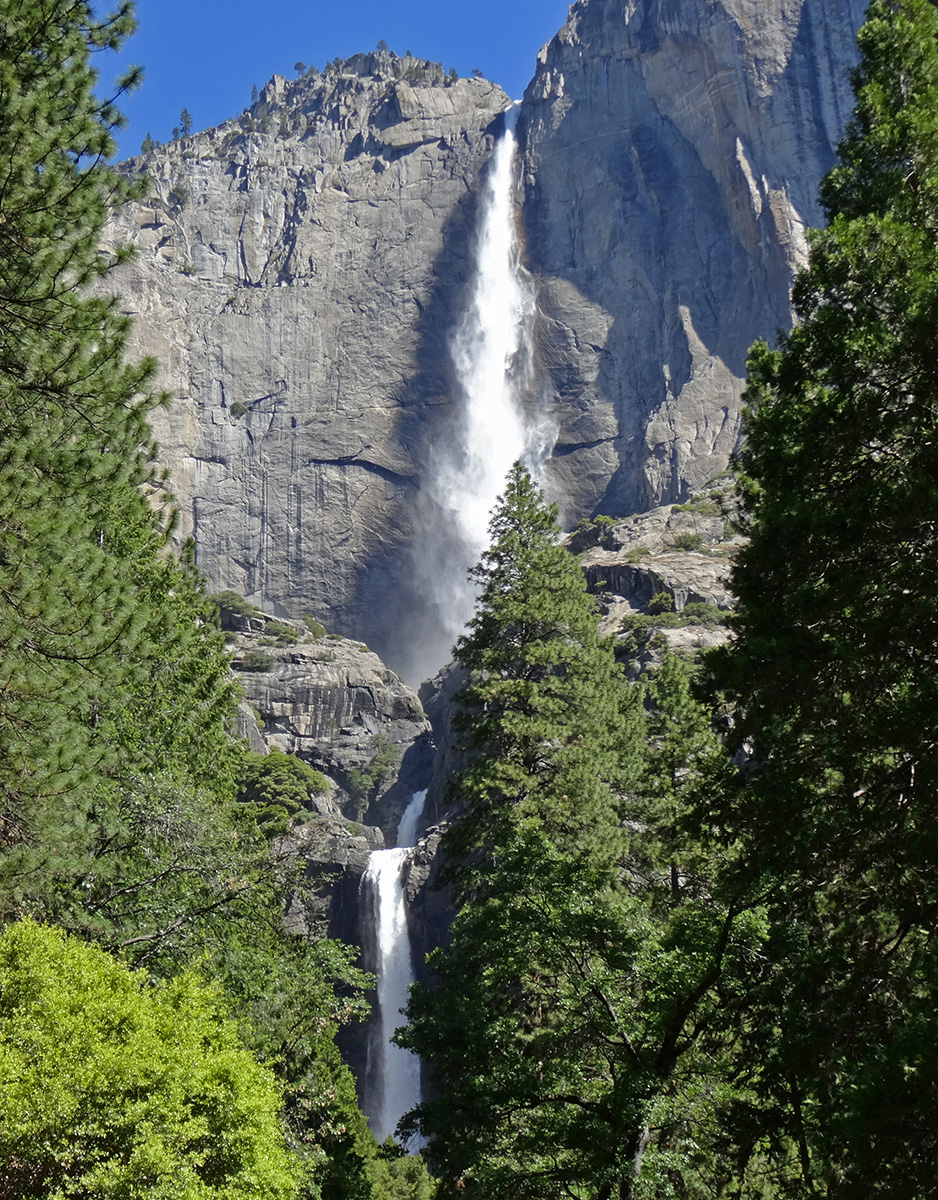 Despite the unwillingness of many countries, especially the oil and coal producing countries, to phase out fossil fuels, there are reasons for hope that global warming may be halted and eventually even reversed. Damage will have been done and some tipping points may have been reached, but further tipping points may be averted.
Despite the unwillingness of many countries, especially the oil and coal producing countries, to phase out fossil fuels, there are reasons for hope that global warming may be halted and eventually even reversed. Damage will have been done and some tipping points may have been reached, but further tipping points may be averted.
The first reason is technological advance. Research, development and investment in zero carbon technologies is advancing rapidly. As we have seen, power generation from wind and solar is now cheaper than from fossil fuels. And this cost difference is likely to grow as technology advances further. This positive tipping point is becoming more rapid. Other technological advances in transport and industry will further the shift towards renewables and other advances will economise on the use of power.
The second is changing attitudes. With the environment being increasingly included in educational syllabuses around the world and with greater stress on the problems of climate change in the media, with frequent items in the news and with programmes such as the three series of Planet Earth, people are becoming more aware of the implications of climate change and how their actions contribute towards the problem. People are likely to put increasing pressure on businesses and governments to take action. Growing awareness of the environmental impact of their actions is also affecting people’s choices. The negative externalities are thus being reduced and may even become positive ones.
Articles
- Global Tipping Points
University of Exeter, Global Systems Institute, Timothy M. Lenton et al. (6/12/23)
- Report: Pivotal moment for humanity as tipping point threats and opportunities accelerate
Phys.org (6/12/23)
- Earth is closing in on catastrophic climate ‘tipping points’, over 200 scientists warn
Independent, Vishwam Sankaran (6/12/23)
- Earth on verge of five catastrophic climate tipping points, scientists warn
The Guardian, Ajit Niranjan (6/12/23)
- Cop28: King Charles warns of ‘vast, frightening experiment’ on natural world
The Guardian, Fiona Harvey, Nina Lakhani, Aletha Adu, Damian Carrington, Patrick Greenfield and Oliver Milman (1/12/23)
- UK likely to miss Paris climate targets by wide margin, analysis shows
The Guardian, Fiona Harvey (5/12/23)
- Water and the High Price of Bad Economics
Project Syndicate, Mariana Mazzucato , Partha Dasgupta, Nicholas Stern, and Johan Rockström (1/12/23)
- Fossil fuels: Can humanity really kick its addiction?
BBC News, Justin Rowlatt (10/12/23)
- Five climate change solutions under the spotlight at COP28
BBC News, Mark Poynting (6/12/23)
- COP28: Five reasons for optimism on climate
BBC News, Matt McGrath (8/12/23)
- COP28 Agreement Signals “Beginning of the End” of the Fossil Fuel Era
UN Climate Press Release (13/12/23)
- COP28 climate summit ends with deal to transition away from fossil fuels
CNBC, Ruxandra Iordache and Sam Meredith (13/12/23)
- Cop28 landmark deal agreed to ‘transition away’ from fossil fuels
The Guardian, Adam Morton, Fiona Harvey and Patrick Greenfield (13/12/23)
- COP28 draft agreement drops phaseout of fossil fuels
Financial Times, Attracta Mooney, Aime Williams and Alice Hancock (13/12/23)
- Examining COP28’s potential impact on climate change
BBC News, Matt McGrath (13/12/23)
- Cop28 failed to halt fossil fuels’ deadly expansion plans – so what now?
The Guardian, Damian Carrington (14/12/23)
- The momentum of the solar energy transition
Nature Communications, Femke Nijsse, Jean-Francois Mercure, Nadia Ameli, Francesca Larosa, Sumit Kothari, Jamie Rickman, Pim Vercoulen and Hector Pollitt (17/10/23)
 COP28: Bill Gates on climate optimism, wealth and the human condition
COP28: Bill Gates on climate optimism, wealth and the human conditionBBC News on YouTube, Bill Gates (2/12/23)
- From the Paris agreement to COP28, how oil and gas giants try to influence the global climate agenda
The Conversation, Alain Naef (8/12/23)
- COP28: Phasedown or Phaseout, Fossil Fuels Must be Addressed to Meet 1.5C Goal
Forbes, Felicia Jackson (5/12/23)
Questions
- Use a diagram to demonstrate the effects of negative externalities in production on the level of output and how this differs from the optimum level.
- Use another diagram to demonstrate the effects of negative externalities in consumption on the level of consumption and how this differs from the optimum level.
- What was agreed at COP28?
- What incentives were included in the agreement to ensure countries stick to the agreement? Were they likely to be sufficient?
- What can governments do to encourage positive environmental tipping points?
- How may carbon taxes be used to tackle global warming? Are they an efficient policy instrument?
- What can be done to change people’s attitudes towards their own carbon emissions?
 HS2 has been cancelled north of Birmingham. The prime minister, Rishi Sunak, announced this at the Conservative Party conference on 4 October, some 13 years after the plan was adopted by the Labour government to build a new high-speed railway from London to Birmingham, which then would branch into two legs – one to Manchester and one to Leeds. The initial budget for this was £15.8bn to £17.4bn. When it came to power, the Conservative-Liberal coalition government ordered a review of the plan. In light of this, the government gave the green light in January 2012 for the full Y-shaped project to go ahead. The London–Birmingham leg was planned to open in 2026 and the two northern legs from 2033.
HS2 has been cancelled north of Birmingham. The prime minister, Rishi Sunak, announced this at the Conservative Party conference on 4 October, some 13 years after the plan was adopted by the Labour government to build a new high-speed railway from London to Birmingham, which then would branch into two legs – one to Manchester and one to Leeds. The initial budget for this was £15.8bn to £17.4bn. When it came to power, the Conservative-Liberal coalition government ordered a review of the plan. In light of this, the government gave the green light in January 2012 for the full Y-shaped project to go ahead. The London–Birmingham leg was planned to open in 2026 and the two northern legs from 2033.
 The project was divided into two phases: Phase 1 to Birmingham and Phase 2 to Manchester and Leeds. The Phase 1 parliamentary bill became law in February 2017 and soon after that, various construction contracts were signed. After some delays, preparation for construction work began in June 2019. There was growing doubt, however, about the viability of the northern legs.
The project was divided into two phases: Phase 1 to Birmingham and Phase 2 to Manchester and Leeds. The Phase 1 parliamentary bill became law in February 2017 and soon after that, various construction contracts were signed. After some delays, preparation for construction work began in June 2019. There was growing doubt, however, about the viability of the northern legs.
On becoming prime minister in 2019, Boris Johnson ordered an independent review of the project after estimates that the costs of the full project would be some £88bn. The review, chaired by Douglas Oakervee, was published in December 2019 (for a link, see list of reports below). It found that costs (in 2015 prices) were likely to be between £62bn and £69bn. Nevertheless, it concluded that the project should proceed: that the original rationale for HS2 still held; that there were:
no shovel-ready alternative investments in the existing network that were available: if HS2 were to be cancelled, many years of planning work would be required to identify, design and develop new proposals; that the upgrading of existing lines would also come at a high passenger cost with significant disruption; that there would be serious consequences for the supply chain, the fragile UK construction industry and confidence in UK infrastructure planning if HS2 were to be cancelled at this late stage.
In February 2020, the prime minister announced that HS2 would go ahead, including the legs to Manchester and Leeds. The Department for Transport published a document (see source line to the following table) giving the full business case for Phase 1 and the outline case for Phase 2. The document itemised the costs and benefits as estimated at the time.
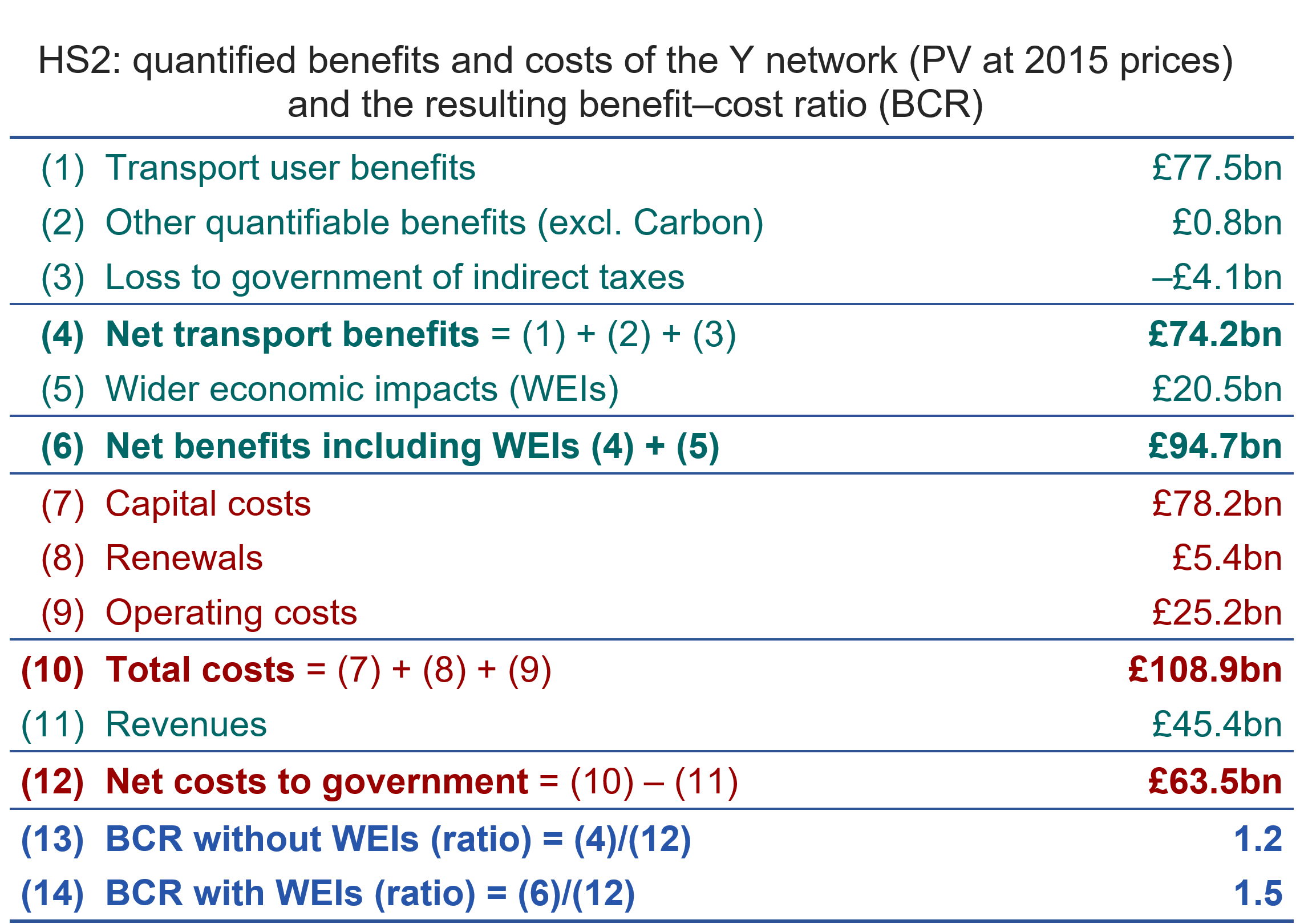
Source: Full Business Case: High Speed Two, Table 2.9, Department for Transport (April 2020)
Box 12.6 in Economics (eleventh edition) and Case study 8.16 on the Essentials of Economics (ninth edition) student website looks at these costs and benefits. The above table is taken from the box/case study. Net transport benefits (present value at 2015 prices) were estimated to be £74.2bn. These include benefits to passengers from shorter journey times, greater reliability, greater connectivity and less crowding, and reduced congestion on roads. They also include other benefits, such as a reduction in carbon emissions and a reduction in road accidents. Net benefits also include the wider benefits from greater connectivity between firms (resulting in increased specialism, trade and investment), greater competition and greater labour mobility. These wider benefits were estimated to be £20.5bn, giving total net benefits of £94.7bn.
Total costs to the government were estimated to be £108.9bn and revenues from fares to be £45.4bn, giving total net costs of £63.5bn. This gave a benefit/cost ratio of 1.5 (£94.7bn/£63.5bn). In the light of these findings, the government announced in September 2020 that the main work on the London to Birmingham leg would begin, despite the Public Accounts Committee’s finding that the project was badly off course and lacking in transparency.
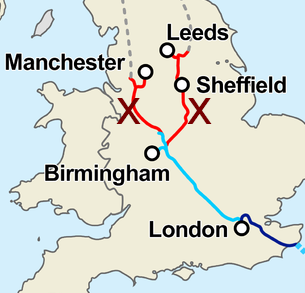
Concern was expressed over whether the Leeds leg would go ahead, but in May 2021, the transport secretary, Grant Shapps, confirmed that it would be completed. However, with the publication of the Integrated Rail Plan in November 2021 (for a link, see list of reports below), the government decided that the eastern leg of HS2 would no longer reach Leeds but instead end in the East Midlands. Then in June 2022, the link between the HS2 line near Manchester and the West Coast Main Line was scrapped. This would have allowed HS2 trains to reach Scotland.
In early 2023, it was announced that the building of the terminus at Euston was being put on hold. Many interpreted this as meaning that it was being scrapped, with trains terminating at Old Oak Common, some six miles from Central London.
Finally, as we have seen, HS2 north of Birmingham has now been scrapped and the government is seeking private-sector funding to build the terminus at Euston and complete the line from Old Oak Common.
Arguments for scrapping the northern legs
The main argument given by the government was that projected costs have risen substantially above original estimates and that by cancelling the Manchester and east Midlands legs, the money saved could be better used elsewhere. The argument is one of opportunity cost. The cost of going ahead would mean not going ahead with better-value alternatives.
The government claims that £36bn will be saved and that this will be diverted to rail, road and other transport projects, primarily (although not exclusively) in the north of England. The money would be spent between 2029 and 2040. Projects include spending additional money on the planned upgrading of the rail link between Manchester and Liverpool, Sheffield, Leeds and Hull; building a new station at Bradford; developing a mass transit system for Leeds and its surroundings; a £2.5bn fund for improved transport for smaller cities, towns and the countryside in the north of England; extra funding for transport in the east and west Midlands, including funding a Midlands Rail Hub. Out of the £36bn, £6.5bn would be for projects elsewhere, including road improvement.
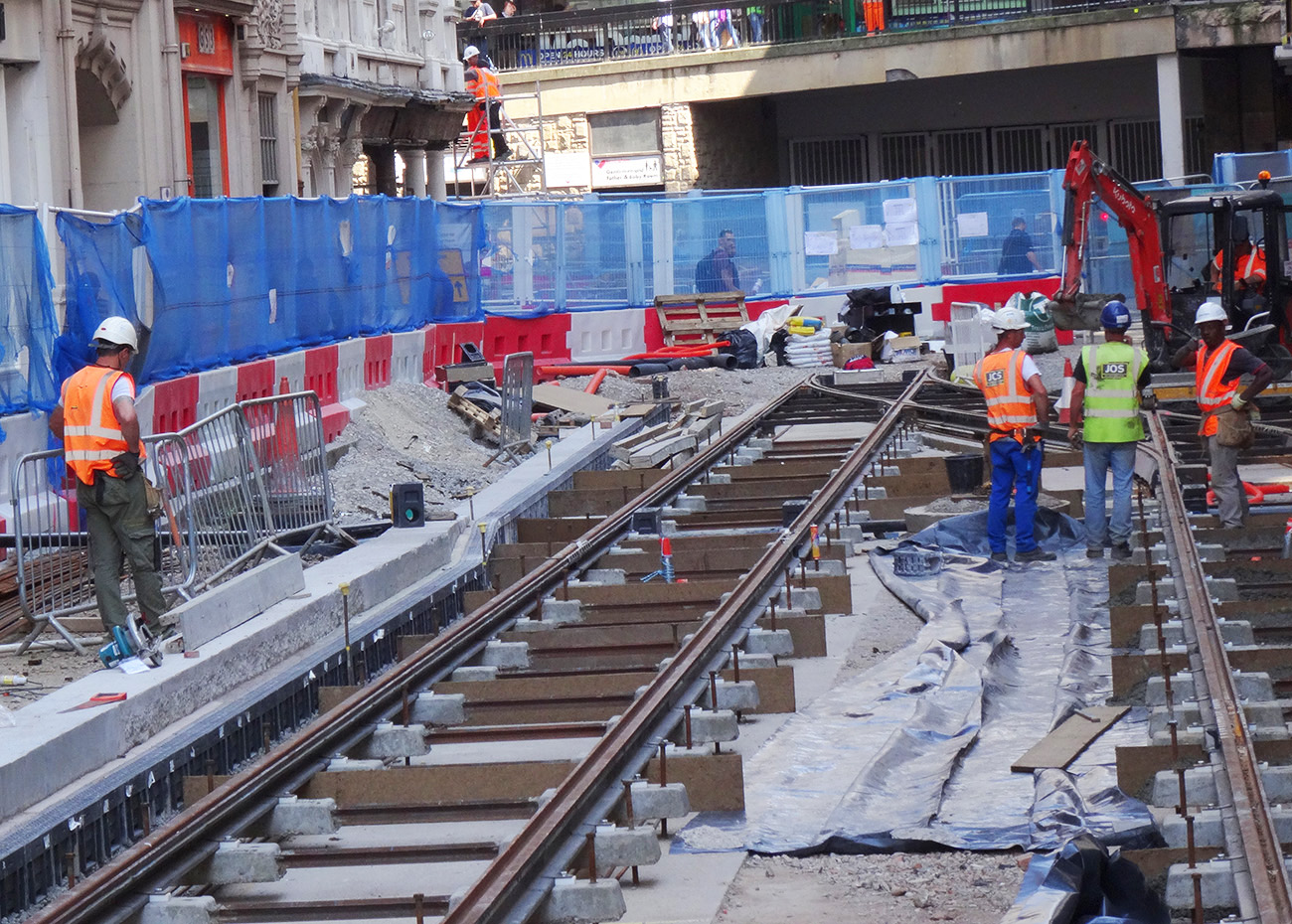 In order to judge whether the diversion of funds represents a better use of money, a full analysis of costs and benefits of the various projects would need to be conducted and compared with an updated cost–benefit analysis of continuing with the legs to Manchester and the east Midlands and possibly reinstating the Leeds leg too.
In order to judge whether the diversion of funds represents a better use of money, a full analysis of costs and benefits of the various projects would need to be conducted and compared with an updated cost–benefit analysis of continuing with the legs to Manchester and the east Midlands and possibly reinstating the Leeds leg too.
One possible benefit for the government is a political one. It hopes that promising more local projects rather than HS2 will appeal to the electorate in large parts of the north of England who are suffering from poor and unreliable transport links. However, most of these projects will be started well beyond the next election and this political gain may turn out to be small. Indeed, cancelling HS2 may breed cynicism, with people wondering whether any promised new projects will actually be delivered.
Arguments against scrapping the northern leg(s)
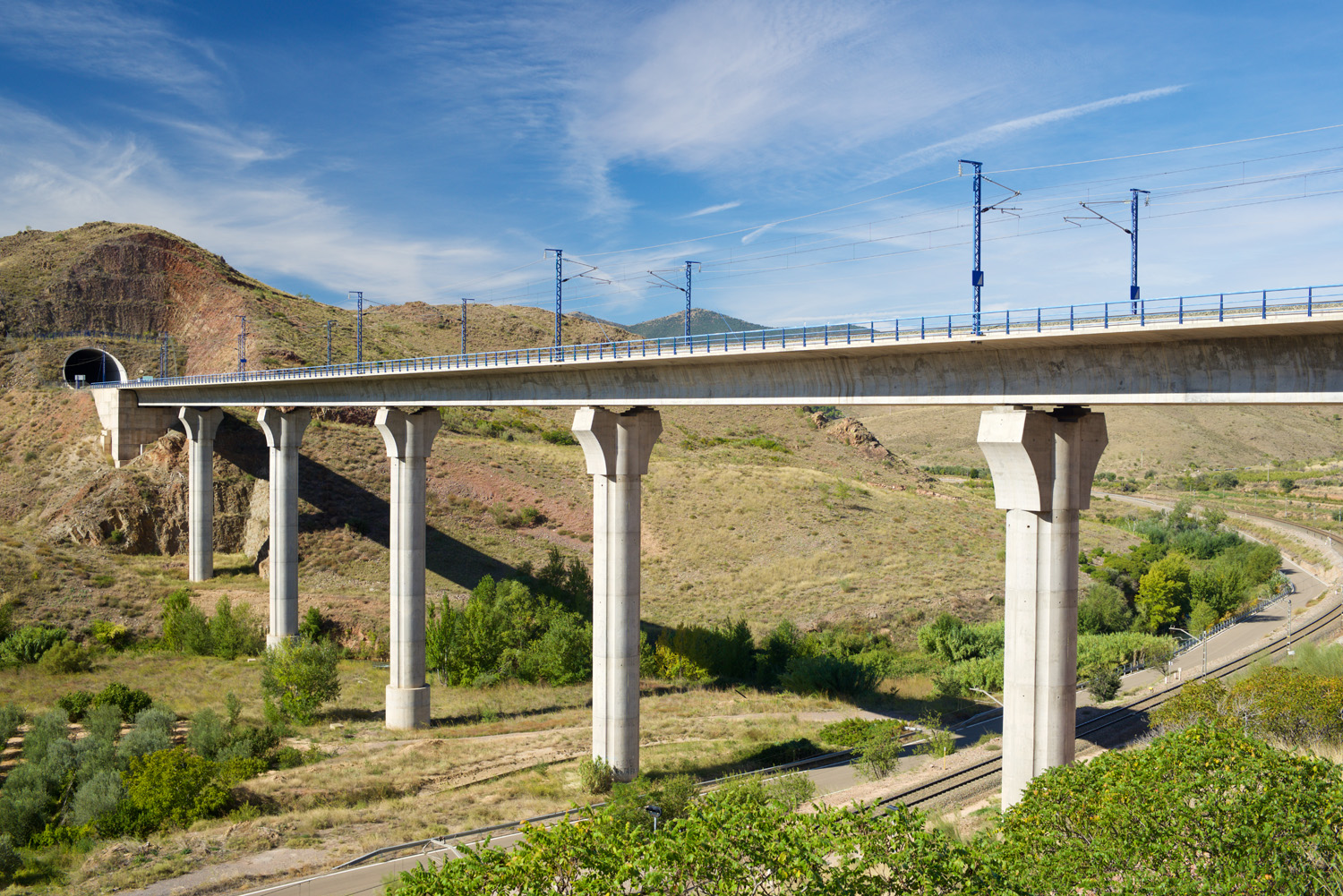 The benefits originally identified from HS2 will now be lost. It is not just that the northern legs of HS2 would have provided faster travel to Manchester and Leeds, but the new lines would have reduced congestion for slower trains and freight on existing lines. This has been the experience in countries such as Japan and Spain, which have invested heavily in new, separate high-speed lines.
The benefits originally identified from HS2 will now be lost. It is not just that the northern legs of HS2 would have provided faster travel to Manchester and Leeds, but the new lines would have reduced congestion for slower trains and freight on existing lines. This has been the experience in countries such as Japan and Spain, which have invested heavily in new, separate high-speed lines.
When the line is completed to Birmingham, the HS2 trains will be able to continue north of Birmingham on existing lines. But these lines are heavily congested, which will limit the number of HS2 trains that can use them. Also they will be restricted to 110 mph on these lines as they have no tilting mechanism. Also they will have a maximum capacity of only 550 seats (a single train set) as the platforms at Manchester Piccadilly cannot accommodate double-set trains. The existing Pendalino trains on the West Coast mainline can travel at 125 mph as they do have the tilting mechanism and they have a higher capacity of 607 seats.
Then there are the signals that cancellation sends to industry about whether governments can be trusted to follow through on public-sector projects. Many business had expanded or relocated to places near the HS2 routes. Many others will wonder whether the promised new projects will go ahead. Indeed, shortly after giving a list of the projects (some of which had already been built or were being built), the list was removed from the government website. There is already a mood of scepticism amongst the electorate. Polling following the initial announcement showed that a majority believed that it was unlikely that the Conservatives would deliver the other projects if they won the next election.
The opportunity cost argument that the money would be better spent on alternative transport projects is predicated on various assumptions. One is that the money will actually be spent, which, as we have seen, people consider doubtful. Another is that the only choice is either spending a fixed pot of money on the northern leg(s) of HS2 or spending it on the alternative projects announced by the prime minister. It could be argued that the government should proceed with both the full HS2 and these other projects, and fund it by extra taxation. Investment as a percentage of GDP is low in the UK compared with other countries. Over the past 10 years, it has averaged 17.8% in the UK. This compares with 21.0% in the USA, 21.5% in Germany, 23.7% in France and 25.4% in Japan. Also, public-sector investment is low in the UK compared with that in other countries.
Assessing the arguments
Many of the costs and benefits of long-term projects, such as HS2, occur many years hence. There is, therefore, a great deal of uncertainty over their magnitude. This makes it extremely difficult to reach a clear conclusion over the desirability of cancelling HS2 north of Birmingham or continuing with it. Under such circumstances, politics tends to dominate decision making.
Articles
- Rishi Sunak promises more rail, road and bus links
BBC News (4/10/23)
- The HS2 rail line: what has been cut and what will replace it?
Financial Times Gill Plimmer, Phillip Georgiadis, Jennifer Williams and Jim Pickard (4/10/24)
 HS2 explained: What is the route now, what are the costs and why is the Manchester leg being axed?
HS2 explained: What is the route now, what are the costs and why is the Manchester leg being axed?Sky News, Sarah Taaffe-Maguire (5/10/23)
- Rishi Sunak finally axes HS2 in the north – weeks after The Independent revealed plan
Independent, Jon Stone and Adam Forrest (4/10/23)
- HS2 | Timeline of a mistreated megaproject
New Civil Engineer, Rob Hakimian (4/10/23)
- HS2 scale-back creates ‘chilling effect’
Construction News, Catherine Moore (5/10/23)
- How HS2 caused the UK to lose focus on ‘levelling up’ during years of high-speed rail delays
The Conversation, Steven McCabe (28/9/23)
- What Rishi Sunak scrapping HS2 – and promising a new ‘Network North’– means for the north of England
The Conversation Tom Arnold (4/10/23)
- HS2: Why Rishi Sunak’s big gamble may not pay off
BBC News, Faisal Islam (5/10/23)
- ‘Managed decline’: the uncertain future for British rail after cuts to HS2
Financial Times, Philip Georgiadis, Gill Plimmer and Jim Pickard (6/10/23)
 Investment outside London could bring £100bn boost to economy, says Bank of England’s former chief economist
Investment outside London could bring £100bn boost to economy, says Bank of England’s former chief economistChannel 4 News, Helia Ebrahimi interviews Andy Haldane (27/9/23)
- HS2 surgery is the wrong choice say leading academics
RailTech, Simon Walton (3/10/23)
- Why has HS2 ended up being so expensive?
The Guardian, Gwyn Topham (25/9/23)
- Ten problems with Rishi Sunak’s Network North announcement
The Guardian, Helen Pidd (5/10/23)
- International investors are laughing at the HS2 shambles
The Guardian, Nils Pratley (4/10/23)
- Spain’s high-speed trains aren’t just efficient, they have transformed people’s lives
The Guardian, María Ramírez (11/10/23)
Government Press Release
Reports
Questions
- Why have the costs of HS2 (in real terms) risen substantially since the first estimates in 2012?
- Identify the types of environmental costs and benefits of the full Y-shaped HS2 project. Why might such costs and benefits be difficult to measure?
- Is the opportunity of cost of proceeding with the full Y-shaped HS2 a range of other transport projects? Explain.
- Find out the level of public-sector investment expenditure as a percentage of (a) total government expenditure and (b) GDP in some other developed countries and compare them with the UK. Comment on your findings.
- Should the decision whether or not to go ahead with the Manchester and east Midlands legs have been delayed until a new updated cost–benefit analysis had been conducted?
- If most of the benefits from the originally planned HS2 will be now be lost with the line ending at Birmingham, should this leg to Birmingham also be cancelled, even though many of the costs have already been incurred? Explain your reasoning.
 Sustainability has become one of the most pressing issues facing society. Patterns of human production and consumption have become unsustainable. On the environmental front, climate change, land-use change, biodiversity loss and depletion of natural resource are destabilising the Earth’s eco-system.
Sustainability has become one of the most pressing issues facing society. Patterns of human production and consumption have become unsustainable. On the environmental front, climate change, land-use change, biodiversity loss and depletion of natural resource are destabilising the Earth’s eco-system. Sustainable finance has grown rapidly over the past decade as concerns about climate change have intensified. A significant element of this growth has been in global debt markets.
Sustainable finance has grown rapidly over the past decade as concerns about climate change have intensified. A significant element of this growth has been in global debt markets. Let’s trace the process. In models of sustainable finance, financial instruments such as green bonds funding investments with positive environmental impacts (such as renewable energy) should be valued more, while instruments funding investments with negative environmental impacts (such as fossil fuels) should be valued less. The prices of the green bonds financing renewable energy projects should rise while the prices of conventional bonds financing fossil-fuel companies should fall.
Let’s trace the process. In models of sustainable finance, financial instruments such as green bonds funding investments with positive environmental impacts (such as renewable energy) should be valued more, while instruments funding investments with negative environmental impacts (such as fossil fuels) should be valued less. The prices of the green bonds financing renewable energy projects should rise while the prices of conventional bonds financing fossil-fuel companies should fall. Figure 2 shows the difference in yields on a ‘green bond’ and its conventional counterpart, both maturing on 15/8/2050, between June 2021 and July 2024. The yield on the green bond is lower – on average about 2.2 basis points (0.022 percentage points) over the period. This represents the sacrifice in financial return that investors are prepared to trade off for higher environmental and social welfare in the future. (Click here for a PowerPoint.)
Figure 2 shows the difference in yields on a ‘green bond’ and its conventional counterpart, both maturing on 15/8/2050, between June 2021 and July 2024. The yield on the green bond is lower – on average about 2.2 basis points (0.022 percentage points) over the period. This represents the sacrifice in financial return that investors are prepared to trade off for higher environmental and social welfare in the future. (Click here for a PowerPoint.) Who killed the ESG party?
Who killed the ESG party?
 Coastal communities face the dual threats of sea-level rise and more intense storms.4 Erosion and inundation damage homes, infrastructure and livelihoods, displacing populations and disrupting local economies. The loss of coastal ecosystems further compounds these challenges, reducing natural defences against storm surges and exacerbating the impacts of climate-related disasters.
Coastal communities face the dual threats of sea-level rise and more intense storms.4 Erosion and inundation damage homes, infrastructure and livelihoods, displacing populations and disrupting local economies. The loss of coastal ecosystems further compounds these challenges, reducing natural defences against storm surges and exacerbating the impacts of climate-related disasters. Displacement due to climate-related disasters amplifies social inequalities and challenges urban planning and infrastructure.7 Vulnerable communities, often located in low-lying areas or informal settlements, bear the brunt of climate impacts, facing the loss of homes, livelihoods and community cohesion. Inadequate housing and infrastructure increase the risks associated with extreme weather events, perpetuating cycles of poverty and vulnerability.
Displacement due to climate-related disasters amplifies social inequalities and challenges urban planning and infrastructure.7 Vulnerable communities, often located in low-lying areas or informal settlements, bear the brunt of climate impacts, facing the loss of homes, livelihoods and community cohesion. Inadequate housing and infrastructure increase the risks associated with extreme weather events, perpetuating cycles of poverty and vulnerability. A happy New Year for 2024. Let’s hope that the coming year brings some good news amidst all the the gloom of war, squeezed living standards, the effects of climate change and the rise of authoritarian regimes.
A happy New Year for 2024. Let’s hope that the coming year brings some good news amidst all the the gloom of war, squeezed living standards, the effects of climate change and the rise of authoritarian regimes. More recently, debt-for-for nature swaps have become popular again.
More recently, debt-for-for nature swaps have become popular again.
 According to the report, five tipping points are imminent with the current degree of global warming (1.2oC). These are:
According to the report, five tipping points are imminent with the current degree of global warming (1.2oC). These are:
 The environment as a common resource. The air, the seas and many other parts of the environment are not privately owned. They are a global ‘commons’. As such, it is extremely difficult to exclude non-payers from consuming the benefits they provide. Because of this property of ‘non-excludability’, it is often possible to consume the benefits of the environment at a zero price. If the price of any good or service to the user is zero, there is no incentive to economise on its use. In the case of the atmosphere as a ‘dump’ for greenhouse gases, this results in its overuse. Many parts of the environment, however, including the atmosphere, are scarce: there is rivalry in their use. As people increase their use of the atmosphere as a dump for carbon, so the resulting global warming adversely affects the lives of others. This is an example of the tragedy of the commons – where a free resource (such as common land) is overused.
The environment as a common resource. The air, the seas and many other parts of the environment are not privately owned. They are a global ‘commons’. As such, it is extremely difficult to exclude non-payers from consuming the benefits they provide. Because of this property of ‘non-excludability’, it is often possible to consume the benefits of the environment at a zero price. If the price of any good or service to the user is zero, there is no incentive to economise on its use. In the case of the atmosphere as a ‘dump’ for greenhouse gases, this results in its overuse. Many parts of the environment, however, including the atmosphere, are scarce: there is rivalry in their use. As people increase their use of the atmosphere as a dump for carbon, so the resulting global warming adversely affects the lives of others. This is an example of the tragedy of the commons – where a free resource (such as common land) is overused. Even if governments want the world to reduce carbon emissions, they would rather that the cost of doing so is born less by their own country and more by other countries. This creates a prisoner’s dilemma, where the optimum may be for a large global reduction in carbon emissions, but the optimum is not achieved because countries individually are only prepared to reduce a little, expecting other countries to reduce more. Getting a deal that is deemed ‘fair’ by all countries is very difficult. An example is where developing countries, may feel that it is fair that the bulk of any cuts, if not all of them, should be made by developed countries, while developed countries feel that fixed percentage cuts should be made by all countries.
Even if governments want the world to reduce carbon emissions, they would rather that the cost of doing so is born less by their own country and more by other countries. This creates a prisoner’s dilemma, where the optimum may be for a large global reduction in carbon emissions, but the optimum is not achieved because countries individually are only prepared to reduce a little, expecting other countries to reduce more. Getting a deal that is deemed ‘fair’ by all countries is very difficult. An example is where developing countries, may feel that it is fair that the bulk of any cuts, if not all of them, should be made by developed countries, while developed countries feel that fixed percentage cuts should be made by all countries. In terms of reducing carbon emissions, the key is reducing the consumption of carbon-producing activities and products that involve emissions in their production. This can be achieved through taxes on such products and/or subsidies on green alternatives (see the blog ‘
In terms of reducing carbon emissions, the key is reducing the consumption of carbon-producing activities and products that involve emissions in their production. This can be achieved through taxes on such products and/or subsidies on green alternatives (see the blog ‘ Despite the unwillingness of many countries, especially the oil and coal producing countries, to phase out fossil fuels, there are reasons for hope that global warming may be halted and eventually even reversed. Damage will have been done and some tipping points may have been reached, but further tipping points may be averted.
Despite the unwillingness of many countries, especially the oil and coal producing countries, to phase out fossil fuels, there are reasons for hope that global warming may be halted and eventually even reversed. Damage will have been done and some tipping points may have been reached, but further tipping points may be averted. HS2 has been cancelled north of Birmingham. The prime minister, Rishi Sunak, announced this at the Conservative Party conference on 4 October, some 13 years after the plan was adopted by the Labour government to build a new high-speed railway from London to Birmingham, which then would branch into two legs – one to Manchester and one to Leeds. The initial budget for this was £15.8bn to £17.4bn. When it came to power, the Conservative-Liberal coalition government ordered a review of the plan. In light of this, the government
HS2 has been cancelled north of Birmingham. The prime minister, Rishi Sunak, announced this at the Conservative Party conference on 4 October, some 13 years after the plan was adopted by the Labour government to build a new high-speed railway from London to Birmingham, which then would branch into two legs – one to Manchester and one to Leeds. The initial budget for this was £15.8bn to £17.4bn. When it came to power, the Conservative-Liberal coalition government ordered a review of the plan. In light of this, the government  The project was divided into two phases: Phase 1 to Birmingham and Phase 2 to Manchester and Leeds. The Phase 1 parliamentary bill became law in February 2017 and soon after that, various construction contracts were signed. After some delays, preparation for construction work began in June 2019. There was growing doubt, however, about the viability of the northern legs.
The project was divided into two phases: Phase 1 to Birmingham and Phase 2 to Manchester and Leeds. The Phase 1 parliamentary bill became law in February 2017 and soon after that, various construction contracts were signed. After some delays, preparation for construction work began in June 2019. There was growing doubt, however, about the viability of the northern legs.

 In order to judge whether the diversion of funds represents a better use of money, a full analysis of costs and benefits of the various projects would need to be conducted and compared with an updated cost–benefit analysis of continuing with the legs to Manchester and the east Midlands and possibly reinstating the Leeds leg too.
In order to judge whether the diversion of funds represents a better use of money, a full analysis of costs and benefits of the various projects would need to be conducted and compared with an updated cost–benefit analysis of continuing with the legs to Manchester and the east Midlands and possibly reinstating the Leeds leg too. The benefits originally identified from HS2 will now be lost. It is not just that the northern legs of HS2 would have provided faster travel to Manchester and Leeds, but the new lines would have reduced congestion for slower trains and freight on existing lines. This has been the experience in countries such as Japan and Spain, which have invested heavily in new, separate high-speed lines.
The benefits originally identified from HS2 will now be lost. It is not just that the northern legs of HS2 would have provided faster travel to Manchester and Leeds, but the new lines would have reduced congestion for slower trains and freight on existing lines. This has been the experience in countries such as Japan and Spain, which have invested heavily in new, separate high-speed lines.